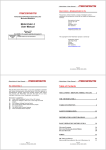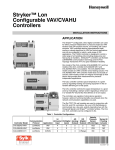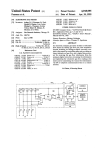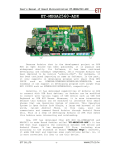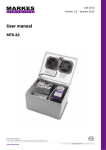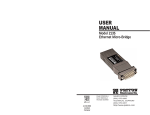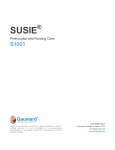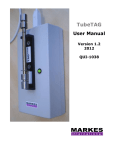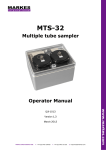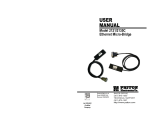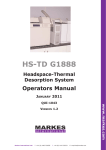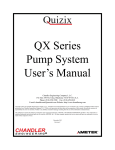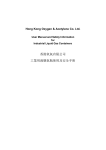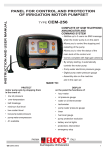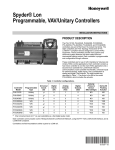Download FLEC AIR PUMP 1001 Operators` Manual
Transcript
FLEC AIR PUMP 1001 Operators Manual JULY 2009 www.markes.com QUI-1030 VERSION 1.2 Markes International Ltd. T: +44 (0) 1443 230935 F: +44 (0) 1443 231531 E: enquiries@markes.com FLEC Air Pump 1001 User Manual Markes International www.markes.com This page left intentionally blank QUI-1030 V 1.2 July 09 Markes International Ltd. T: +44 (0) 1443 230935 F: +44 (0) 1443 231531 E: enquiries@markes.com FLEC Air Pump 1001 User Manual Markes International FLEC AIR PUMP 1001 Operators’ Manual Contents 1. Introduction 4 2. Operating instructions 5 2.1. Operating modes 5 2.1.1. SET Mode 5 2.1.2. RUN Mode 5 2.1.3. EXTERNAL Mode 5 2.2. Pump 1001 Calibration program 5 2.2.1. Software set up 7 2.2.1.1. Flow Calibration procedures 8 2.3. Adjusting the pump 12 3. Specifications 14 List of Figures Figure 1. Figure 2. Schematic of FLEC pump showing connections and buttons 4 The pump calibration window 7 Flow calibration window 9 Figure 3. Non-linear flow sensor calibration curve (black) and Pump 1001 6 linear calibration covering flw range a-b (blue) Selecting the Comport 7 Figure 5. The calibration and settings window Figure 4. Figure 6. Figure 7. 9 Calibration graph produced by flow calibration wizard 11 Establishing the low calibration point Figure 10. Accepting the calibration Figure 11. Check and adjust function QUI-1030 V 1.2 July 09 Markes International Ltd. 10 11 13 -3T: +44 (0) 1443 230935 F: +44 (0) 1443 231531 E: enquiries@markes.com www.markes.com Flow Calibration Wizard Figure 8. Figure 9. 8 FLEC Air Pump 1001 User Manual Markes International 1. Introduction The FLEC air pump 1001 (figure 1) was developed in response to the special requirements of the Field and Laboratory Emission Cell (FLEC) 1. However, it is equally applicable to any air-sampling or air-metering application within its flow range. PWR Display MODE UP SET DOWN Sensor socket Chemanet socket Needle valve Power Supply Air in Figure 1: Schematic of FLEC pump showing connections and buttons The FLEC applications require an adjustable well regulated constant and pulseless air flow on both the suction and the pressure side of the pump. Therefore the FLEC air pump 1001 is based on a rotating displacement pump unit augmented by a pulse damping unit, and regulated by a microprocessor based servo-mechanism that takes its signal from a highly accurate and sensitive mass flow sensor. The pump unit contains a microprocessor and memory to read AD-converter values from the flow, temperature and humidity measuring circuits and to calculate and display the flow, temperature and humidity using linear calibrations stored in the memory. The pump comes factory calibrated for flow (mL/min), temperature (°C) and relative humidity (% RH). However, other and/or more accurate flow calibrations over a different or narrower flow range can be obtained by using the optional pump 1001 calibration program (see section 2). QUI-1030 V 1.2 July 09 Markes International Ltd. -4T: +44 (0) 1443 230935 F: +44 (0) 1443 231531 E: enquiries@markes.com www.markes.com Many FLEC applications require the temperature and humidity of the air passed through the FLEC cell to be determined. Therefore, the pump can also determine the temperature and relative humidity using an external dual sensor electrically connected to the pump and with provisions for inserting the sensor into the air stream where required. FLEC Air Pump 1001 User Manual Markes International 2. Operating instructions Connect the 12 Volt DC power supply to your mains and to the Power supply socket (rectangular with 2 pins) in the upper right corner of the connection plate. Turn the pump on by pressing the PWR button, and holding it down. While pressing the button the display shows the name of the pump e.g. Air Pump 1001-A. When the button is released the display shows the serial number and the pump ID. To turn the pump off, press and hold the PWR button. The display initially reads “Power Off” followed by a series of dashes (- - - -). At this point, the pump is turned off and the button can be released. The delay is present to prevent accidental shutting down of the pump. 2.1. Operating modes The pump has 3 modes of operation: 1. Settings mode (SET MODE) 2. Running mode (RUN MODE) 3. Chemanet communication mode (EXTERNAL MODE) 2.1.1. SET Mode In SET MODE, (MODE entered when you power on the pump), the pump can be programmed to: a. Wait for a delay time with flow = 0 (1st setting, “del”) b. Run for a set run time with the set flow (2nd setting, “run time”) c. Repeat a and b a set number of times (3rd setting, “cycles”) d. Run at a specified flow In order to store and keep new values entered in the pump manually in SET mode, the pump must be changed to run mode or external mode before switching off. 2.1.2. RUN Mode In RUN MODE the pump executes the program entered in the SET MODE (the Settings). It is possible to read the current flow, temperature and humidity from the pumps display in the RUN MODE. In EXTERNAL mode the pump can communicate with a PC over a serial network - the CHEMANET. The pump can be completely controlled from a PC in the EXTERNAL MODE. This mode is used to calibrate the flow, temperature and humidity measurements for a given pump-sensor combination, and to change the settings (Flow, Delay Time, Run Time and Cycles) used in RUN mode. Therefore, whereas there are two mechanisms for entering the settings (via the software or directly on the pump) the pump can only be calibrated from a PC over the CHEMANET with the pump in EXTERNAL MODE. 2.2. Pump 1001 Calibration program The purpose of the program is to prepare the pump for standalone operation and document the calibration and settings used for this operation. QUI-1030 V 1.2 July 09 Markes International Ltd. -5T: +44 (0) 1443 230935 F: +44 (0) 1443 231531 E: enquiries@markes.com www.markes.com 2.1.3. EXTERNAL Mode FLEC Air Pump 1001 User Manual Markes International The program can: • Calibrate the flow, temperature and humidity measurements for a given pumpsensor combination. • Change settings (Flow, Delay Time, Run Time and Cycles) used in RUN MODE. • Store calibrations and settings in the pumps memory (for use in stand-alone operation). • Save calibration and settings to disk files for later retrieval. • Read the calibration and settings data from the pumps memory. • Change the Name and the ID of the pump. • Make reports of the calibration data and settings in the pumps memory for onscreen viewing, printing, or exporting to file for importing into other programs. • Check and adjust the pump High calibration point Mass flow sensor output curve Low calibration point Calibration line covering flow range a - b a b Figure 2: Non-linear flow sensor calibration curve (black) and Pump 1001 linear calibration covering flow range a - b (blue) QUI-1030 V 1.2 July 09 Markes International Ltd. -6T: +44 (0) 1443 230935 F: +44 (0) 1443 231531 E: enquiries@markes.com www.markes.com Flow sensor output (AD-value) Note: It is very important to calibrate the flow sensor around and close to the flow at which it will operate because a calibration curve made over the entire flow range 0 to 1000 ml/min is not linear (as shown in Figure 2). The pump contains one calibration line covering a specified part range of the complete flow range of the pump. If the pump is to operate outside this part-range the calibration line in the pump must be changed to one whose part-range covers the desired flow value. The pump is precalibrated using a 50 and 100 mL/min flow with a deviation of 1.5 mL/min. It is not recommended to go below 40 mL/min and above 130 mL/min without additional calibration. FLEC Air Pump 1001 User Manual Markes International Using the calibration program the pump can be calibrated to any required accuracy within the resolution of the AD converter (± 1AD unit) using a narrow flow interval. Each of the three measuring circuits (for flow, temperature and humidity) delivers its measured result to an AD converter (Analog to Digital), which is a voltmeter that can be read (digitally) by the processor in the pump. The voltmeter measures voltages from 0 to 4.095 V with a resolution of 1 mV (0.001 Volt). Calibration establishes what real value (flow in ml/min, temperature in °C or humidity in % RH) corresponds to a given AD converter voltage (AD value) read from the corresponding AD converter, and reports this real value. 2.2.1. Software set up • Download software onto PC (“Release” folder, Pump 1001 Calibration program) • Connect pump to PC via Chemanet cable, into comport 1, 2, 3 or 4 • Open FLEC AIR PUMP 1001 Calibration program • Go to <Options> and <Select comport>: Figure 3: Selecting the Comport • Select the comport number and press <OK> • Switch on the pump by pressing the PWR button, and then hold down the “M” key until EXTERNAL MODE is displayed. • Go to options select pump (scans network for pump). • The pump calibration window should now be open displaying the air pump and serial number: QUI-1030 V 1.2 July 09 Markes International Ltd. -7T: +44 (0) 1443 230935 F: +44 (0) 1443 231531 E: enquiries@markes.com www.markes.com Figure 4: The pump calibration window FLEC Air Pump 1001 User Manual Markes International The serial number (Serial No.) is the hardware identification of the individual physical pumps and is set by the factory and cannot be changed. The PumpID (Address No.) serves to identify the pump on the CHEMANET network. No two pumps on a network can have the same PumpID. An important function of this program is to change duplicate PumpIDs. The Name (Name) is a user identification that can be changed and used as best suited for the purpose of the pump. Use it to identify the pump by position or function in the application in which it takes part. The pump name also appears in the reports. 2.2.1.1. Flow Calibration procedures • Install a reference flow meter to the pump outlet and a reference sample tube to the pump inlet prior to calibration. • From the menu select <Functions> followed by <Calibrations and settings>. The calibration and settings window should now be opened: Figure 5: The calibration and settings window This is where the operations on the individual pumps maybe performed i.e. changing their Identification, Settings, Calibrations, and from where the pumps are checked and adjusted. • Initiate a flow calibration by clicking in the flow ref. (High or Low). This opens the flow calibration window: QUI-1030 V 1.2 July 09 Markes International Ltd. -8T: +44 (0) 1443 230935 F: +44 (0) 1443 231531 E: enquiries@markes.com www.markes.com A two point calibration is used. To get the best calibration of the flow make reference set points close to the flows you are going to use, do not make reference set points differ more than 100 mL/min. FLEC Air Pump 1001 User Manual Markes International Figure 6: Flow calibration window • Select <Linear Calibration Wizard>. This opens the calibration wizard which consists of 4 steps: • Select <Next> to get to the second wizard page where the low calibration point is established: QUI-1030 V 1.2 July 09 Markes International Ltd. -9T: +44 (0) 1443 230935 F: +44 (0) 1443 231531 E: enquiries@markes.com www.markes.com Figure 7: Flow Calibration Wizard FLEC Air Pump 1001 User Manual Markes International Figure 8: Establishing the low calibration point The graph shows the ‘continuously’ measured AD value from the flow sensor. This is used to determine the stability of the flow: • To make the pump produce the flow itself drag the black vertical handle in the SetServo control below the graph or write the AD value you want the servo mechanism to keep in the SetServo field - the value only takes effect when you leave the field by clicking outside or press the tab key. Having established the flow, you have to measure it using an external flowmeter attached to the Air outlet and enter the value you read from the external flowmeter in the field <Low Flow ml/min>. • Adjust the needle valve on the side of the pump to increase the flow resistance, and obtain a more stable flow (less noisy). Note: Care should be taken not to overtighten the valve and subsequently work the pump too hard (See section 2.3) • When the standard deviation of five measurements is less than 1% of the measured mean, the <Next> button becomes available • Once this is complete select <Next>, which shows a graph of the calibration as produced by the wizard: QUI-1030 V 1.2 July 09 Markes International Ltd. -10T: +44 (0) 1443 230935 F: +44 (0) 1443 231531 E: enquiries@markes.com www.markes.com • Select <Next> to establish the high calibration point and repeat the procedures as for the low calibration point FLEC Air Pump 1001 User Manual Markes International Figure 9: Calibration graph produced by flow calibration wizard • Select <OK> and the calibration window is displayed with two linear calibrations on the graph with the option to either accept the wizard calibration as the current calibration, or to keep the current calibration. www.markes.com Figure 10: Accepting the calibration QUI-1030 V 1.2 July 09 Markes International Ltd. -11T: +44 (0) 1443 230935 F: +44 (0) 1443 231531 E: enquiries@markes.com FLEC Air Pump 1001 User Manual Markes International Note: The calibration steps described above only change the calibration data in PCmemory. To make them effective in the pump when operated as a stand-alone unit (i.e. to change them in the pump’s memory), you must save them to the pump using menu <File/Calibration/Save to pump>. Additionally, when the current pump is changed, the program will compare the data in PC-memory to the data in the pump and there will be an option to either save the now current data in the PC-memory to the pump, or revert to what is in the pump’s memory. 2.3. Adjusting the pump When the pump is operating at a low “speed”, either because the SET flow is low or because the resistance to the airflow is low (or both), the servo mechanism becomes unstable and the flow pulsates. This can be heard in the pitch of the motor. To stabilise the flow increase the speed of the motor by increasing the resistance to the flow (described below). Furthermore, when the pump is operating at a high “speed”, the resistance to airflow can be too high and the speed of motor should be decreased. This is done by decreasing the resistance to airflow. Note: The resistance to the airflow is very important to the correct operation of the pump, therefore it is vital to check the speed of the motor at the SET flow required with any external resistance e.g. the sorbent tube, in line. Note: that different sorbent tubes (i.e. packed with different sorbent(s)) will have different resistances. In order to change the resistance adjust the needle valve (see figure 1). Note: It is vital not to overtighten the needle valve. It should only be used when a moderate increase in flow resistance is needed to get a stable flow. To check and adjust the flow, use the “Check and Adjust” function in the Calibration program. This can be used to: a. Check that you actually get the flow you have preset in the operating environment. b. Adjust the flow resistance (needle valve on the pump) so that you get a pulseless flow at the preset value, in the actual the operating environment. c. Check the temperature and humidity measured by the sensor. • From the calibrations and settings window select <Functions> followed by <Check and adjust pump>. This opens the check pump window: Markes International Ltd. www.markes.com QUI-1030 V 1.2 July 09 -12T: +44 (0) 1443 230935 F: +44 (0) 1443 231531 E: enquiries@markes.com FLEC Air Pump 1001 User Manual Markes International Figure 11: Check and adjust function This gives an interactive graphic picture of the flow and any variations in flow, and their amplitudes are displayed. • Enter the flow at which the pump will be operating in the field <ServoGoal>. The pump will then start the servo mechanism to maintain the flow at the specified value. • The blue curve shows the individual measurements, and the red curve shows the current mean value of the last <Points in mean> number of measurements. • Adjust the needle valve on the side of the pump to increase the flow resistance, and obtain a more stable flow (less noisy). • The graph, and the mean and individual values together with the current values, shown above the graph, check whether the pump is actually delivering the flow required. Note: for further and more detailed information on the calibration of the FLEC pump please refer to the <Help> function in the menu. Markes International Ltd. www.markes.com QUI-1030 V 1.2 July 09 -13T: +44 (0) 1443 230935 F: +44 (0) 1443 231531 E: enquiries@markes.com FLEC Air Pump 1001 User Manual Markes International 3. Specifications FLEC Air Pump 1001 Part no. FL-1001 Pump Type Sealed, oil free, rotary displacement pump controlled by a microbridge mass airflow sensor. Weight 400 g Casing Aluminium and POM, 130 x 40 x 60 mm Connections ¼” tubings Flow 0 – 999.9 ml/min Pressure Max allowed continuous pressure differential across the rotating displacement unit is 100 mbar. Temperature 4 – 50 °C Humidity 0 – 95% RH Calibration Users flow range is determined by calibration range within the 0 to 1000 ml/min. Normal factory calibration is from 50 to 100 ml/min. Accuracy Depends on calibration, calibration range and absolute size of flow. Flows lower than 4 ml/min are not recommended, since the measurement resolution alone at this low flow amounts to 2 –3%. When calibrated at 50 and 100 ml/min, accuracy is from 0.5% at the calibration points to a maximum of ca 2% between these. Power 12 V DC/200 mA power supply required. Markes International Ltd. www.markes.com QUI-1030 V 1.2 July 09 -14T: +44 (0) 1443 230935 F: +44 (0) 1443 231531 E: enquiries@markes.com














